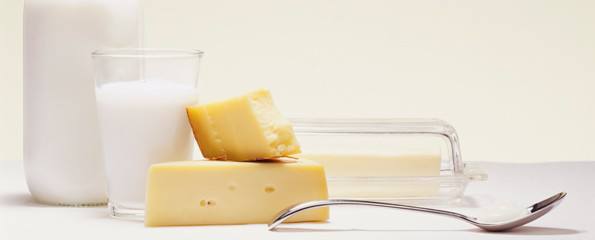Milk and Milk Products (Dairy Products)
- Introduction to milk and milk products
- What are dairy products?
- Sources of dairy products
- Nutritional value of dairy
- Benefits of milk and other dairy products

Introduction
Children and adolescents should be encouraged to consume milk products because this is the period of their lives in which they are building their peak bone mass and developing lifelong habits. This article highlights the benefits of milk and milk products, as well as common misconceptions.
What are dairy products?
A production plant for processing dairy products is called a dairy or a dairy factory. Dairy products are generally defined as food products that are produced from milk. They are rich sources of energy. Raw milk for processing generally comes from cows, but occasionally from other mammals such as goats, sheep, and water buffalo. Water is the main constituent of milk (about 90%).
Sources of dairy products
Milk of various types (including whole milk, skim milk, buttermilk), yoghurt, cheese (e.g. Swiss cheese, cheddar cheese, cottage cheese), and ice cream are dairy products. Of all milk products, milk, yoghurt and cheese are the best sources of calcium.
Nutritional value of dairy
Dairy products and alternatives such as calcium-fortified soy products are nutritious foods, and provide benefit when consumed as part of a nutritionally balanced diet which includes all of the 5 food groups:
- Breads and cereals;
- Vegetables and fruits;
- Dairy products/alternatives;
- Meat/chicken/fish/alternatives; and
- A small amount of fats and oils.
The functions of a food are served specifically through its nutritionally important components, including proteins, carbohydrates, lipids, minerals, vitamins and water. Cow’s milk is the preferred choice for most people. It provides 67 kilocalories and has a protein content of 3.2 grams per 100 millilitres. Milk proteins include casein (about 80%) and whey (about 20%). Whey has a higher nutritional value than casein.
Once fat and casein have been removed from milk, it consists mainly of whey, which contains the soluble milk salts, milk sugar and the remainder of the milk proteins. Whey proteins consist of a number of specialised proteins, the most important being beta lactoglobulin (50% of whey) and lactoglobulin.
Milk proteins have a high biological value but, unlike egg proteins, they lack sulphur-containing amino acids. The proteins in cow’s milk have balanced amino acid profiles and good digestibility, making it the obvious choice when it comes to feeding the family. Casein in cow’s milk combines with calcium to form caseinogen. A higher proportion of calcium and casein in cow’s milk makes it more difficult to digest than human milk. Some people cannot drink fresh milk because they are lactose intolerant, but can consume sour milk because it contains less lactose.
The nutrient composition of milk makes it a time-tested liquid that is indispensable for the maintenance of optimal nutrition, especially for the young. The major nutrients in milk aside from protein include the following:
Milk and milk products also contain fat. Cow’s milk contains fat that is in the form of glycerides. The fat in cow’s milk is a poor source of essential fatty acids.
The fat content of milk varies:
- Whole milk contains 3.9 g fat per 100 ml,
- Semi-skimmed milk provides 1.7 g fat per 100 ml
- Skim milk provides 0.2 g fat per 100 ml
- 1% milk, a blend of skimmed and semi-skimmed milk, has recently become available. It contains 1 g fat or less per 100 ml.
The main carbohydrate in milk is a disaccharide called lactose. It is made up of two simple sugars – glucose and galactose – and is sweeter than sucrose (found in cane sugar). Lactose supports the absorption of calcium and phosphorus and the synthesis of some B complex vitamins in the small intestine. In the human body, an intestinal enzyme called lactase digests lactose. Some people are unable to produce enough lactase, inhibiting lactose digestion. This undigested lactose is then broken down in the large intestine by bacteria, causing the formation of gas, bloating, pain and diarrhoea. This condition is called lactose intolerance.
Lactose intolerance is the inability to digest significant amounts of lactose, the major sugar found in milk. Lactose intolerance poses a problem for some people, but can be managed. People who have trouble digesting lactose should avoid dairy products that are not compatible with their system. Many people with this condition can enjoy milk, ice cream and other such products if they eat them in small amounts or eat other food at the same time. Additionally, lactase liquid or tablets can help digest the lactose.
Lactase deficient individuals may tolerate milk with cereals or cooked as custard more than liquid milk. Some dairy foods contain less lactose than others, and may be better for people who suffer from lactose intolerance. These include:
- Fermented milk products, including some yoghurts, mature cheeses (like cheddar cheese) and butter, generally pose no problems.
- Since heating breaks down some of the lactose, heated milk products such as evaporated milk may be preferred to unheated foods.
Milk and milk products are an excellent source of vitamins and minerals, particularly calcium. Milk has significant amounts of vitamin A and B vitamins such as thiamine, riboflavin and nicotinic acid, but is a poor source of vitamin C and vitamin E. It also contains vitamin B12.
The important minerals in milk are calcium, phosphorus, sodium and potassium. It is, however, a poor source of iron. Calcium is a mineral that the body needs for numerous functions, including building and maintaining bones and teeth, blood clotting, the transmission of nerve impulses, and regulation of the heart‘s rhythm.
Dates
Tags
Created by:

 Login
Login














